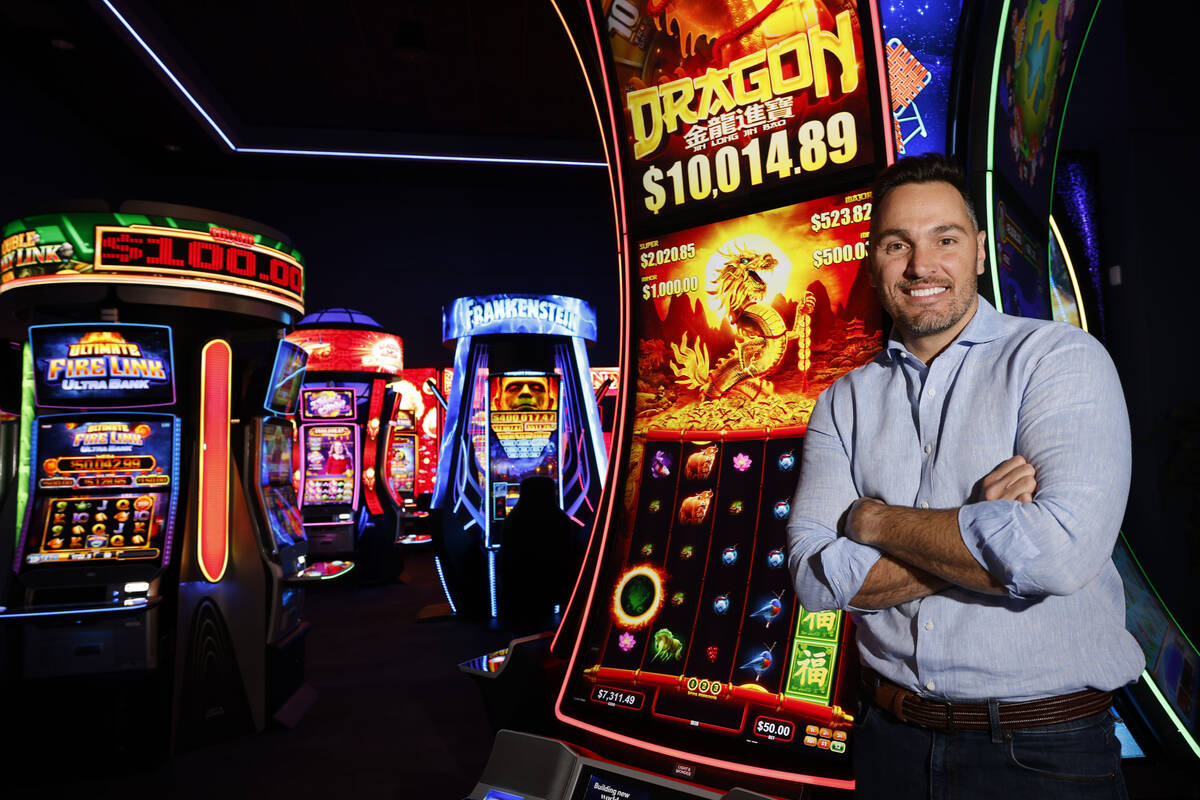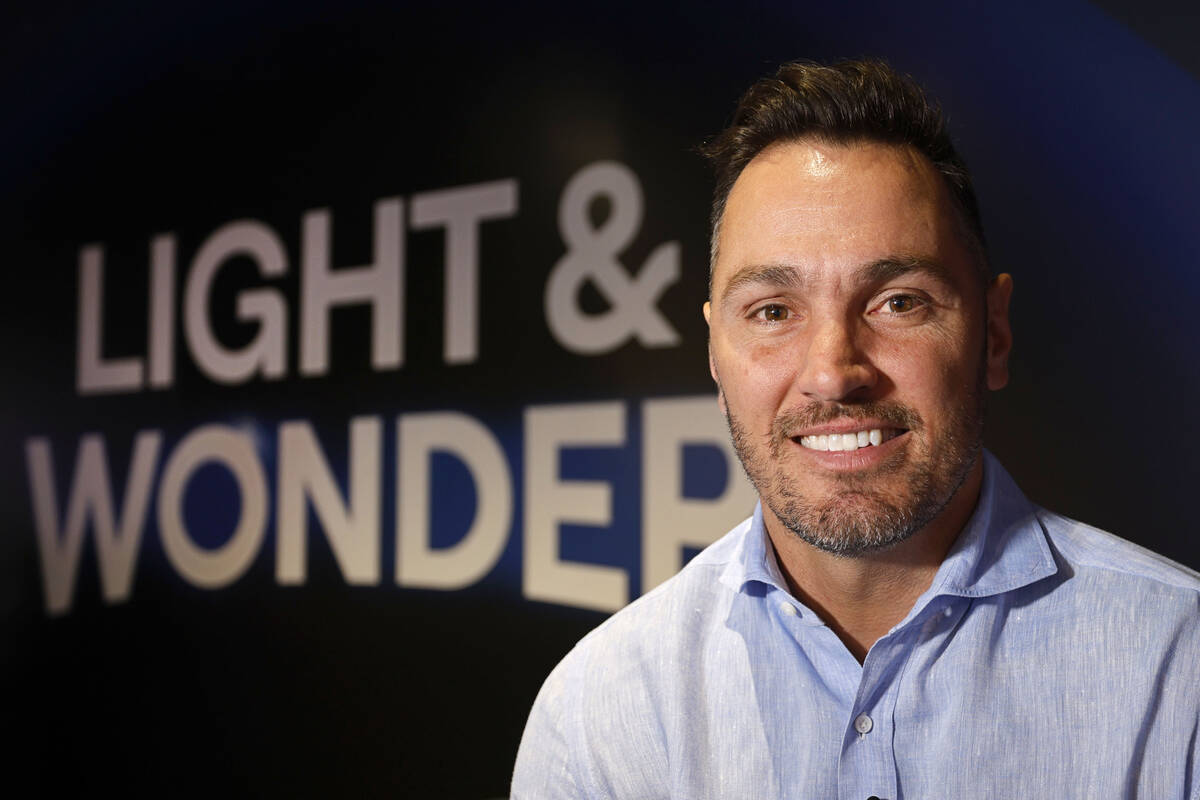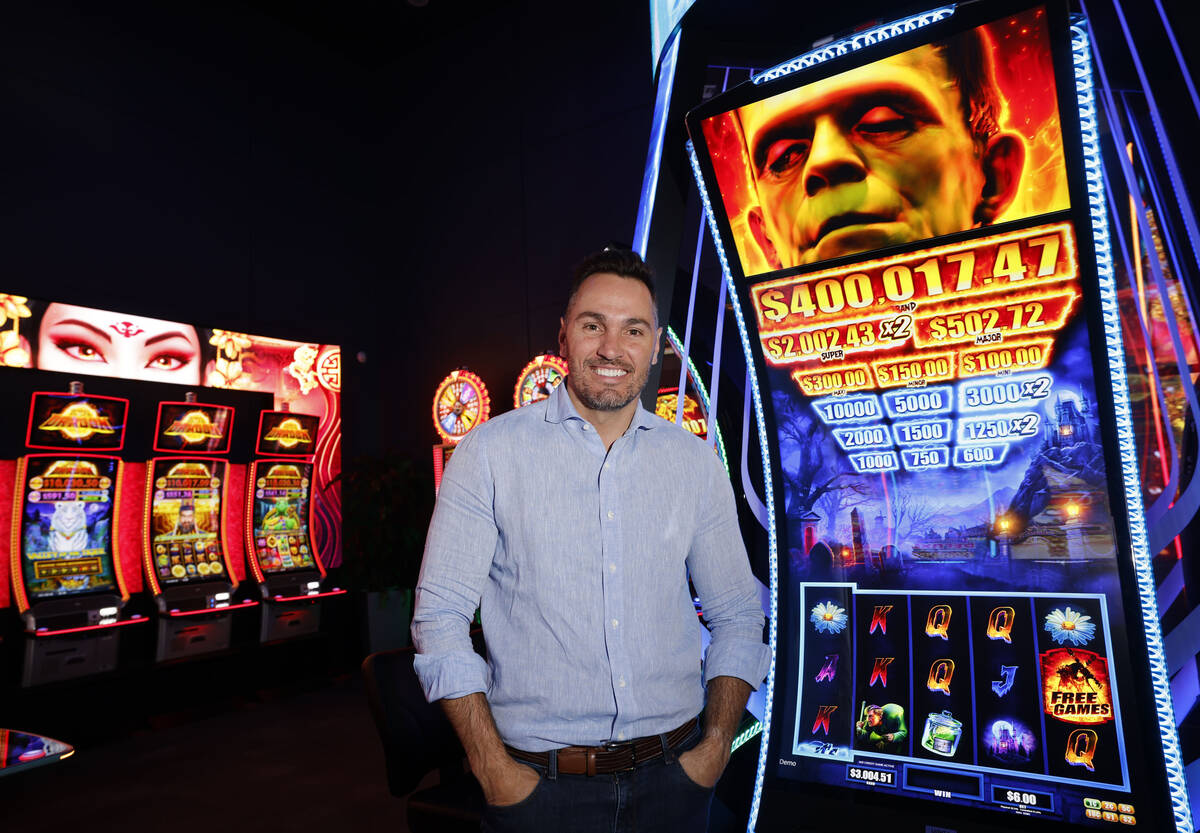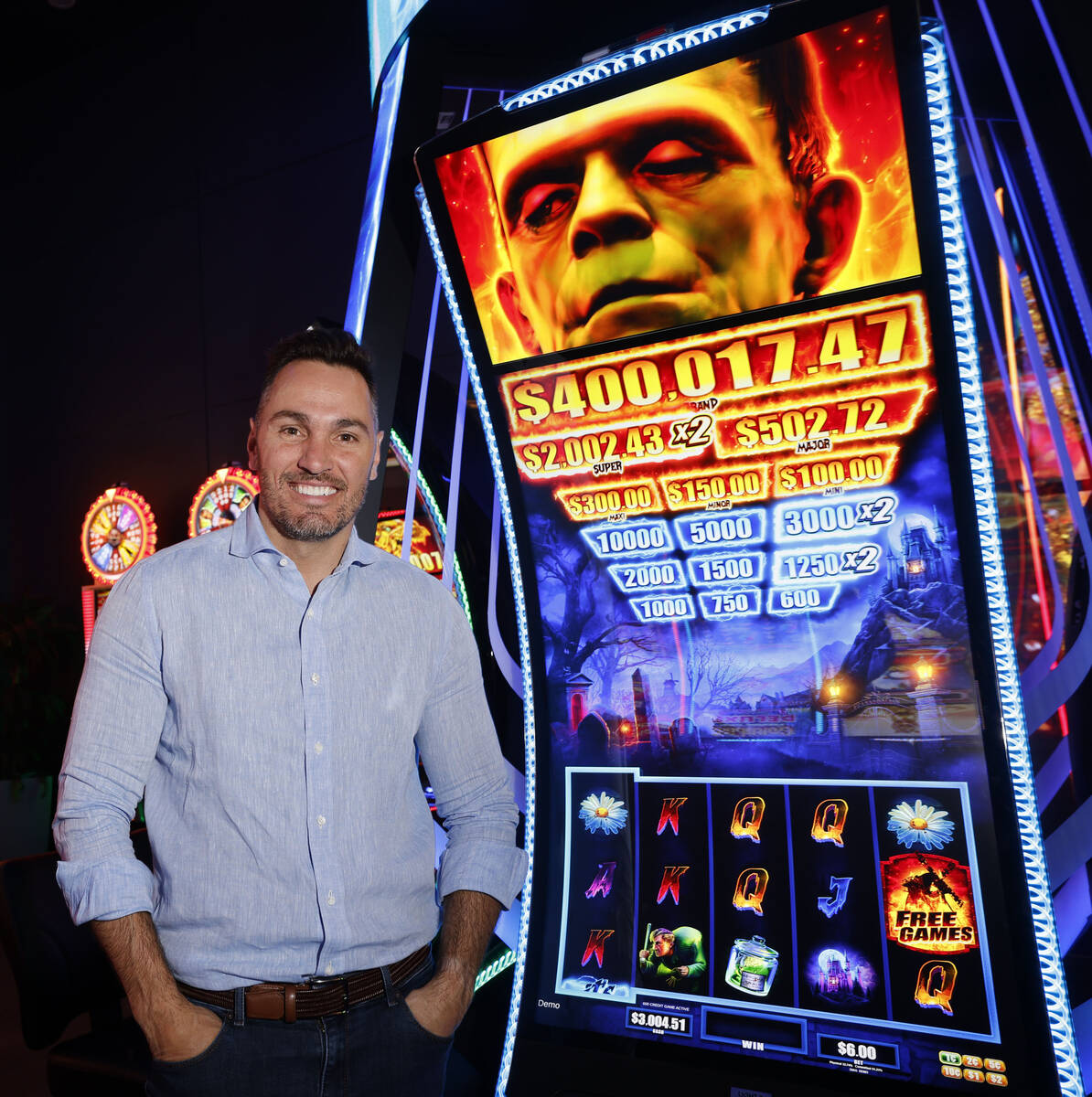Wonder what a company called Light & Wonder does? The CEO explains
The Las Vegas company now known as Light & Wonder has come a long way since its origins as a company called Autotote.
Autotote produced those machines you see at horse racetracks that calculate odds and payments in parimutuel racing.
Then, in 2000, Autotote bought Scientific Games Corp., a leader in instant lottery equipment founded in 1973, for $308 million. A year later, the company took on the Scientific Games name.
Fast forward a couple of decades, and Scientific had taken on billions of dollars in debt after acquiring some of the biggest brands in the gaming business — Bally, WMS and Shuffle Master.
It needed a solution to the crushing debt estimated at $9.2 billion, and company executives determined the answer was to streamline the operation by selling two corporate divisions — its sports betting operation and its lottery division — and then taking on a whole new identity.
Scientific Games ended up selling its lottery business to Brookfield Business Partners for $6.05 billion in October 2021, and then its OpenBet sports wagering system under its new Light & Wonder name to Endeavor Group Holdings Inc. for $800 million in September 2022.
Enter Matt Wilson, who joined Light & Wonder in March 2020 as its executive vice president and group chief executive of gaming.
Wilson was named CEO of Las Vegas-based Light & Wonder in October and has been steering the company through its deleveraging efforts since.
Wilson, educated at the University of Wollongong and the advanced management program at Wharton Business School at the University of Pennsylvania, is Aussie through and through.
He met with the Review-Journal at Light & Wonder’s Las Vegas headquarters for a one-on-one interview.
Review-Journal: For readers unfamiliar with Light & Wonder, describe what your company does and tell us about some of the games the company produces.
Matt Wilson: What we are today is a pure play content and platforms business. We make games and platforms, the research-and-development engine, the center of our universe and the reason we exist. We deploy those games and platforms in these three distinct, unique, world-class but very complementary businesses.
The way to think about Light & Wonder, the three businesses we have, the biggest we have is the land-based gaming business, a supplier to casinos. We make slot machines, table products and systems. Anything that a casino needs to operate their business, we have an offering in that space. Players who are familiar with games would know many of our games: Dancing Drums, Goldfish, Willy Wonka, Wizard of Oz are some of the big brands that we’ve created throughout the years. The second business we have is called SciPlay, it’s our social casino business. It’s really about taking those great brands and franchises that we build on slot machines and deploying them in the mobile free-to-play space. These are apps on your phone, playing slot machines with virtual currency.
The third business we have is the iGaming business, which is a large, mature market in the European and U.K. markets but are really big growth opportunities in the U.S. IGaming is live in six states at the moment, but we see a path to legalization to many more states in the coming years.
Is it a challenge to be in all those different spaces?
I think it was. As Scientific Games was trying to be world class at lottery, world class at sports platforms and world class at content was really hard. … The way I like to say it, in the old Scientific Games, a dollar of investment in our R&D engine would go to building a great lottery experience, a portion of that would go to building a great sports experience and a portion of that would go to content. Now, in the new Light & Wonder, every dollar of investment that we make in games can go across all of these three businesses. It’s a portfolio that just kind of fits together, a very efficient operating model. It makes a lot of sense. Now, building world-class games just becomes a thing we’re obsessed about as an organization.
So Light & Wonder … where did that name come from?
That was a fascinating process. When we sold the lottery business, the original Scientific Games, the name went with it, so we had to rebrand. I had never been through a rebranding before. We brought in all these professionals that do this for a living. We hired linguists to come up with names that sound great and conjure up the right experience. We went through 2,700 options that we could trademark and we decided on Light & Wonder.
We went through and said there really are three stakeholders that we care about. We have our shareholders, they really care about whether the stock price is going up or down, they don’t really care what you’re called. You’ve got customers. They care about what you’re called, but they really care about the quality of the product and whether you deliver on your commitments. So if you do those things, they don’t really care what you’re called.
The third and most important cohort is employees — current employees and future employees. We were trying to tell this story to potential employees that what we do has levity to it. We make games for a living. We’re not in a laboratory making games. It’s about creativity. It’s about engineers, animators, graphic designers and mathematicians, and there’s some wonder about what we do. If you think about looking at these games in a showroom, when you walk across a casino floor, people light up. The lights from the games light them up. When they win, that lights them up. And there’s a sense of wonder about some of these games. When you think about some of these games — Wizard of Oz and Monopoly, there’s wonder about that. So it made a lot of sense and it really was an employee-facing brand, saying “Come and work for us, we make games for a living. That’s our obsession.”
What is the company’s biggest success on the market right now and why?
I think it’s the transformation that’s underway, it’s what’s to come. In the last three years, we’ve gone from 10½x levered. We sold a couple of businesses at peak valuations in 2021. We used that money to repair the balance sheet. We’ve really refocused the business around being great at games. You can see the quality of the products coming through the portfolio, things that we’ve just launched, including a new cabinet called Cosmic. Frankenstein is the No. 1 game in the market right now, so we’re excited about that. I think it’s really about the transformation that’s underway, both financially and culturally.
We’re an integrated business now that’s obsessed about doing world-class games. What’s exciting to me is that it’s showing up in the financials. We had a great first quarter that we announced three weeks ago. We’re growing at peak growth rates across the industry. If you look at the earnings results from Q1, we grew 17 percent top line, 23 percent bottom line. There’s really no one in the industry that’s growing at that rate. We’re a growing organization and it’s an exciting place to be.
What sets Light & Wonder apart from some of your competitors?
I think it’s that combination of those three distinct businesses. The iGaming business we’ve been in for a very long time, we bought the business, called NYX, in 2016. That business had a sports-platform business and an iGaming business. We bought it for $630 million. We sold the sports bid in ‘21 for $800 million so we got the iGaming bid basically for free and a bit of spare change to go with it. Importantly, we got a team in iGaming that’s been at this for more than a decade. It goes back to this idea that we’re the leading cross-platform global games company, so we build games and platforms and we deploy them very efficiently across these three end markets.
I guess the other powerful advantage is the insights you can drive from these three businesses back into the R&D engine to make better games is really powerful. We have lots of customers in the land-based world so we get lots of insights and data from those customers that helps inform us to make better games. The social casino space is really interesting. We have millions of daily active users in our social casino business. We can A-B test games. We can make a red version of a game and a blue version of a game, see which one players like and then use that to better refine the R&D engine. From the iGaming perspective, we have a content aggregation platform that allows us to see what categories are growing and which ones are shrinking. Our chief product officer says gaming is a fashion business. Every year, every season, the fashions change, the types of games the players want to play change and so the most successful companies have their pulse on what’s the fashion of this season and are able to modify their portfolio as they go. Having those three businesses gives us a really powerful advantage to help us be more precise about how we spend our R&D dollars.
What strategies do you have to take a higher market share from some of the big names in gaming manufacturing?
We’re No. 2 in the space. We’re at the low 20s (percentages) in market share depending on the category you’re looking at. We operate in different geographies as well. One of the things that’s interesting about this new Light & Wonder business is the old Scientific Games had this enormous debt on the business. Every dollar of cash flow that we generated went to servicing our debt. Now, we’ve got that leverage under control at 3.1x. What we’ve been able to do is raise our level of R&D investment from 7 percent to 10. …
So we look at that as a percentage of revenue. So we were spending 7 percent of revenue on R&D, the money we use to build games and everything you see and hear. We’ve taken that to 10 percent now, so it’s a lot more dollars to invest behind our ambition, so it’s more studios, it’s more game design talent in those studios, it’s great incentives for great studios.
So as we’ve expanded that R&D as a percentage of revenue and the business is growing, it means it’s throwing off a lot more R&D dollars for us to invest, and a really good example of that is the Australian market. We were about a 7 percent share player in Australia, a distant No. 5 in the market. We put some incremental R&D investment down there. This last quarter, we shipped 22 percent of the market, so we went to a clear No. 2. It just shows you the proof point of where we invest R&D dollars incrementally we can grow our share in markets. So that’s a nice little case study for us.
The gaming industry seems to be riding an impressive wave in most markets, including Nevada. Can the same be said for the manufacturing side?
There are a few things to unpack there. I always tell my team that we exist because our customers exist. To the extent that casinos are having success that does trickle down to suppliers. You can definitely see that in the earnings for us but also for a number of our competitors. I think this kind of macro-uncertainty that we’re facing for the moment is being discriminate about how it affects sectors. There are sectors out there are being crushed by the macro-environment; retail is a good example of that. But I think casinos are really bundled up the idea that consumers want experiences. … The things that are doing well in the market at the moment are airlines are doing well — you go to Harry Reid Airport and there are more people than they’ve ever had coming into the city and leaving the city as well.
If you look at hotels, room rates are way up. If you look at expensive restaurants, it’s hard to get a reservation. People are out consuming experiences, and I think gaming is rolled up into that idea that players want to be out, they want to be consuming experiences and that’s kind of where we’re positioned. So I’d say yes, our customers are doing really well and the supply side of the industry is doing well as a consequence of that. I think how we measure ourselves is what share are we taking in individual markets. It’s not about the rising tide lifting the boats, it’s about how do we go in and compete for players’ wallets and customers’ wallets. We do that by building the best games possible. We’re not targeting any competitor out there and taking share from them, it’s about how do we build better games and that’s our obsession. Better games deliver better outcomes for players and operators and that’s how you win market share over time.
What does your crystal ball tell you about the gaming industry through the rest of the year? Will inflation and the threat of a recession finally reach the gaming industry and is Light & Wonder prepared for that possibility?
I think we live with a healthy level of paranoia, which I think you should as a business leader We look at all of the lead indicators. So we have lots of data points that gives the pulse of the consumer. Gross gaming revenue for operators is one. We have a lot of internal metrics that we have around our games that are out in the field. We have great insight into the iGaming world, how much money is being wagered.
So we have a lot of data points that we have on a dashboard and it’s lit up green for the moment.
There’s nothing on the horizon right now that suggests that some pullback is imminent. I speak with CEOs of operators all the time and ask them about the health of their business. Things are very buoyant in the end markets of the operation. So nothing is pointing to the industry being impacted yet. Obviously, we watch that very carefully and we know what we need to do if there is a pullback and how we should reposition the business. We’re in growth mode right now.
Because you’ve done that before, right?
Well we went through a pandemic, right? So everyone had to flex that muscle. We know what we need to do should that occur, but right now, the end markets are looking really healthy.
The company recently has made efforts to be listed on the Australia Securities Exchange. What’s the strategy of that move and how close are you to accomplishing that?
I may be biased about this, but I think Australians punch above their weight in the gaming industry. You just have to go to any market around the world — I lived in Asia for five years, and in the U.S. for 11 years and traveled all over the world in gaming — and everywhere you go you hear an Aussie accent in the gaming space, whether that’s on the operator side or the supplier side.
The same is true for investors. They know the space intimately and they like it. I think they have an awareness of the gaming industry’s growth. So our business is growing really nicely.
But it’s also resiliency. If you look at economic cycles, gaming has a way of powering through the cycle. That’s really appreciated down there by Australian investors and there’s a lot of Australian nexus points. I’m obviously from there. The company that I used to work for is from there. A lot of the management team here spent time at Aristocrat so investors down there know the management team. Our chairman was the CEO of Aristocrat through their transformation years as was our executive vice chair, she was the chief financial officer at Aristocrat.
So there are a lot of Australian nexus points, a lot of investors had a lot of success in the gaming space. We’ve had a lot of inbound demand. So how do we invest in this story? A lot of the fund managers in Australia can only invest in Australian companies so a secondary listing. The Nasdaq will remain our primary listing, but we now have a secondary listing in Australia that allows Australian investors to invest behind the Light & Wonder story. We launched that two weeks ago and the demand we’ve seen has well exceeded our expectations. These things often need a leap of faith into the unknown, but it has been met with great reception and the amount of volume we’re getting onto that register down there is really impressive.
Contact Richard N. Velotta at rvelotta@reviewjournal.com or 702-477-3893. Follow @RickVelotta on Twitter.





















